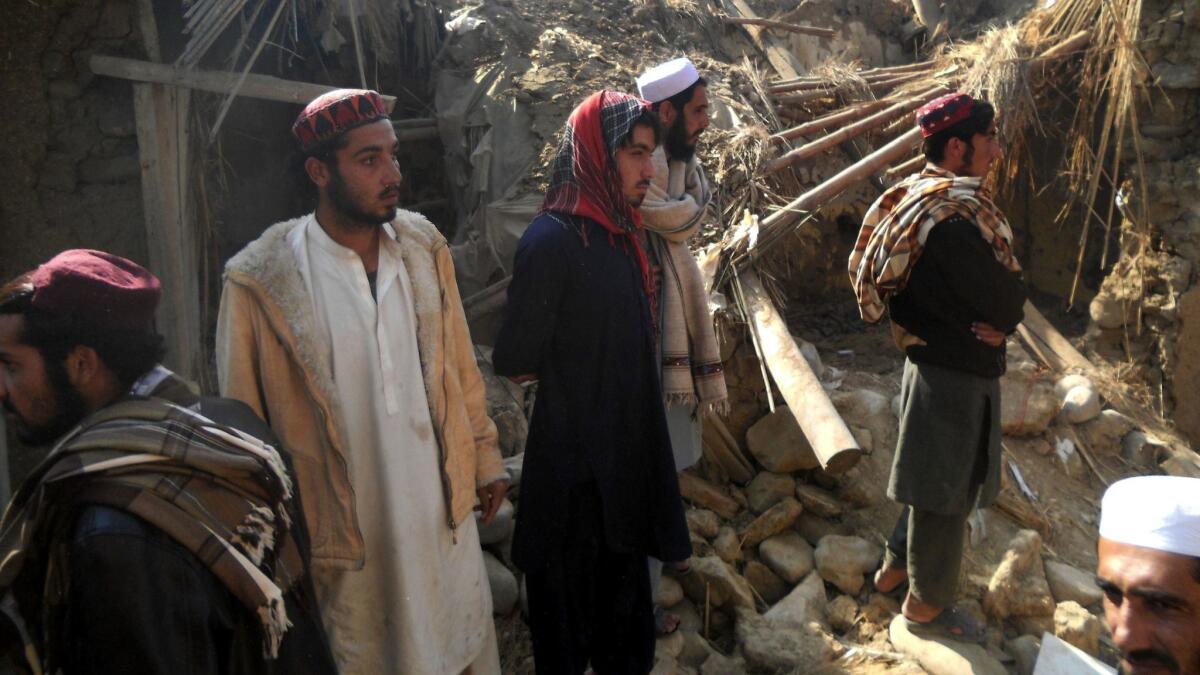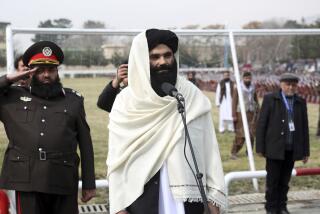Many Americans have never heard of the Haqqani network, one of the world’s most lethal terror groups

- Share via
When the Trump administration announced this week it was suspending military aid to Pakistan until the country takes more aggressive action against terrorist organizations that have targeted Americans, one of the groups it named was the Haqqani network.
Compared to other extremist groups, it is unfamiliar to many people in the U.S.
So who is Haqqani? What is the network? And what are its links to Pakistan?
Jalaluddin Haqqani was an Afghan warlord and a leader of the insurgency against Soviet forces in Afghanistan in the 1980s, when he formed his Sunni Islamist militant organization, which the U.S. government did not designate as a foreign terrorist organization until 2012.
Today the group is based primarily in the North Waziristan region of Pakistan, from which it conducts cross-border operations into eastern Afghanistan and Kabul, according to a counter-terrorism guide published by the U.S. government’s National Counterterrorism Center.
“It is by far the most lethal group, not just inside Afghanistan, but in South Asia in general,” said Ahmad Majidyar, a fellow at the Middle East Institute and an expert on Afghanistan-Pakistan security issues. “The group is more like a criminal mafia group rather than an insurgent group.”
One of its major goals is to reassert the Taliban’s control in Afghanistan and reestablish the Islamic Emirate of Afghanistan, experts said.
Haqqani aligned himself with the Taliban in the mid-1990s and served as its minister of tribal affairs until it was dislodged from power by the U.S. invasion in 2001. He was also a mentor to Al Qaeda leader Osama bin Laden, according to the U.S. counter-terrorism center.
Media reports in 2015 that Haqqani had died have never been confirmed. But at some point, he handed leadership of the network to his son Sirajuddin, who in 2015 was named as a deputy of the Taliban leadership council.
Experts have mixed opinions about the extent of the network’s relationship to the Taliban.
“The group acts completely independently from the Taliban leadership and over the past decade it has carried out its military operations mostly in eastern Afghanistan, quite independently,” Majidyar said.
But Marvin G. Weinbaum, professor emeritus of political science at the University of Illinois at Urbana-Champaign and a former analyst for Pakistan and Afghanistan in the U.S. Department of State’s Bureau of Intelligence and Research, said: “There is very little distance between the Haqqani network and the Taliban. I tend to say they are partnered groups.”
And Bill Roggio, a senior fellow at the Foundation for Defense of Democracies and editor of its Long War Journal, said it was “a complete misnomer to de-link the Haqqani network from the Taliban.”
“It’s like saying the Marines aren’t part of the U.S. military,” he said. “They’re a faction. They’re a branch of the Taliban ... but they are the Taliban.”
The Haqqani network’s high-profile attacks target “anyone who they deem to be in their way of reestablishing the Islamic Emirate of Afghanistan and bringing the Taliban back to power,” Roggio said. That includes Afghan security forces, government buildings, civilians, and Western forces and interests, including the U.S. embassy and military bases.
Since the 2013 death of Mullah Omar, the former supreme commander and spiritual leader of the Taliban, the younger Haqqani has effectively risen to become “one of the major military figures for both movements,” Weinbaum said.
The group is known to maintain close ties to Al Qaeda, the Pakistani Taliban and to the Pakistani military intelligence services, experts said.
It is “well respected amongst the jihadist circles,” Roggio said. “Sirajuddin Haqqani has been used to solve disputes between various factions.”
He said that respect comes in large part from the group’s support for global jihad — the armed conflict to expand the Islamic world — by providing shelter, training camps and financing in Afghanistan and Pakistan.
Experts said it’s impossible to know the size of the group, but some estimates put its membership at upward of 10,000 people, with many recruits coming from the northern Pakistan region where the group is based.
The network is believed to be financed by some Gulf states, including Saudi Arabia, and by the Pakistani establishment. The elder Haqqani reportedly speaks fluent Arabic and is well connected in the Arab Gulf region. One of his two wives is reportedly from the United Arab Emirates. Money generated through the network’s illicit activities, including trafficking in drugs and minerals, also helps fund the group, experts said.
To that end, it aims to create ungovernable areas in eastern Afghanistan where it can safely run its criminal enterprises, Majidyar said.
But its trademark is the sophistication of its assaults. The groups is known to have effective tactical fighters, expertise in car bombs and suicide attacks, and influence in recruiting foreign jihadists, experts said.
“What has made the Haqqani network stand out and also become very much famous is its lethality and also its ability to conduct ... attacks in the most secure and most strategic locations across Afghanistan, but most importantly in the capital, Kabul,” Majidyar said.
Notable attacks in recent years include the June 2011 assault on the Kabul Intercontinental Hotel and suicide bombings in 2008 and 2009 against the Indian Embassy in Kabul, according to the counter-terrorism center.
The agency said the Haqqani network also participated in a September 2011 “day-long assault against major targets in Kabul, including the U.S. Embassy, International Security Assistance Force headquarters, the Afghan presidential palace, and the Afghan National Directorate of Security headquarters.”
For more on global development news, see our Global Development Watch page, and follow me @AMSimmons1 on Twitter
More to Read
Sign up for Essential California
The most important California stories and recommendations in your inbox every morning.
You may occasionally receive promotional content from the Los Angeles Times.











